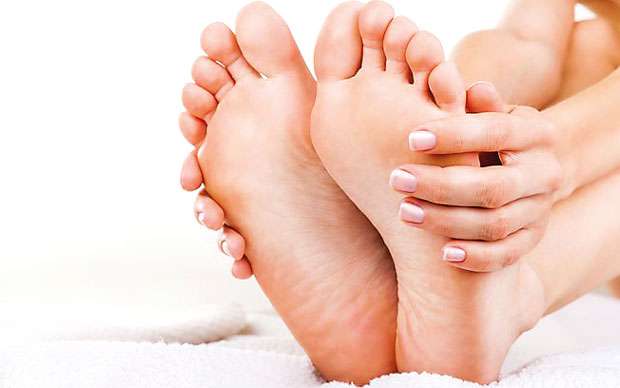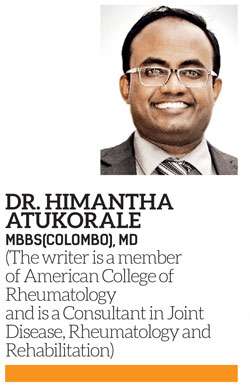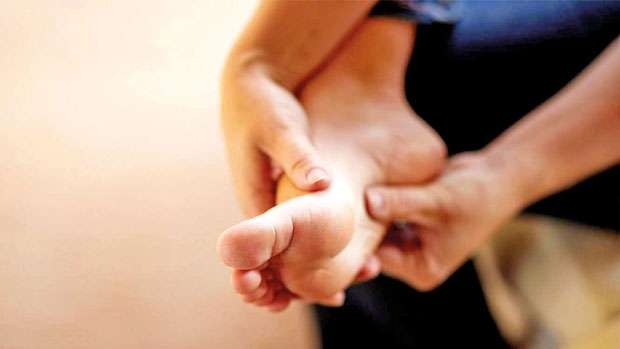Reply To:
Name - Reply Comment

Feet are the tiny structures that bear a significant weight throughout one’s lifespan. Taking good care of your feet means a lifetime of painless mobility. Many Sri Lankans tend to ignore this delicate body structure and its care. Although assembled using one of the tiniest types of bones in the body, the feet are one of the sturdiest structures we could boast of. This article focuses on a few of the most common ailments to affect the feet.
Structure
Feet are the final shock absorbers of your body that directly come in contact with the ground. Whether you jump, run, walk or lift weights these two shock absorbers prevent your body from vibration related damage. There are three curved arches of your feet that act as coils/springs. The ligaments which are strong rubber bands form these arches and also hold all the small particles of the foot together. Not all parts of the feet touch the ground. Out of the five toes you have, the big toe is used to propel the body during the final phases of the walking cycle. The heel acts as a big cushion to bear all the heavy thuds that the body endures. There are many muscles that run all the way up from the leg to help the feet to ‘move-about’. Some muscles help the arches to do their tasks while the others move the toes and the ankles.
Regular self -examination of the feet might be difficult in patients who have arthritis and obesity. Using a foot mirror(an angulated mirror attached to a stick) is advised in these patients
Joint diseases that affect feet
Any form of arthritis can damage the foot. Out of these some of the common conditions are osteoarthritis, rheumatoid arthritis, spondyloarthritis and gout.

Osteoarthritis affects the ankle joint and can damage it through much wear and tear changes. This causes the ankle joints to swell and cause painful limitation during movements. The same condition could damage the mid portion of the foot which we name as mid-foot. The small bones which are usually separated by slippery layers of cartilage then rub against each other. Osteoarthritis damages the forefoot and leads to mal-aligned toes.
Rheumatoid arthritis doesn’t limit itself to bone damage. Swelling is one of the major features of rheumatoid arthritis. This can happen at the ankle joint or even at the level of your toes. One feature which differentiates rheumatoid arthritis from osteoarthritis is that the swelling in the former is a squeezable type. We call this swelling synovitis which is swelling of the covering layer of joints. Sometimes fluid gathers within the joints. The bases of the toes are affected the most during rheumatoid arthritis. The structures on top of the foot are tendons and they are responsible for movements of the feet. Swelling of tendons is called tenosynovitis and is seen in this form of arthritis.
Spondyloarthritis is when the spine and its joints get affected by a process called inflammation. During this disease some of the toes can swell up cylindrically. This is called dactylitis or sausage digits, as the appearance is similar to a plump sausage!
Gout is a joint disease characterised by the collections of uric acid crystals within a joint. Gout can affect any joint in the body, but mainly affects the big toe. This was known as ‘Podagra’ in ancient times. Podagra then was thought to be a disease of the rich, as gout is common in people who drink alcohol and consume red meat!
Other conditions that affect feet
When the longest nerves in your body that supply the feet malfunction, we call it peripheral neuropathy. The result is severe numbness first felt in the toes and later the ankles. Many diseases contribute to peripheral neuropathy out of which diabetes plays a key role. Sometimes certain vitamin deficiencies and small blood vessel problems can give rise to the same symptoms.
Non healing wounds trouble the feet of many. Lack of proper blood supply to the extreme ends of the legs, diabetes, lack of blood drainage from feet due to varicose veins and nerve related issues can lead to these troublesome wounds. Also severe arthritis can cause unnecessary pressure over certain areas causing skin to breakdown.
Callosities are thickened portions of skin adjacent to high pressure areas of the feet. An imbalance of weight bearing secondary to severe arthritis can cause callosities.
Cellulitis is when a germ travels all the way beneath the skin. The feet appear red and swollen in cellulitis. We have to find the source of germ entry in cellulitis and treat this infection promptly.
Cracked heels are a common complaint among my joint disease patients. This can easily be sorted out using special ointments. It is very important to cure cracked heels as this could act as an entry point for many bacteria.
Fungal infections are common in nail beds of toes. Lack of proper foot hygiene matters a lot here. Again standard medication to destroy fungi paves the way to a healthy nail plate.

Taking care of your feet
I should mention that feet are one of the most ignored structures among Sri Lankans when it comes to maintaining a healthy lifestyle. We rarely appreciate the use of proper footwear to protect these important structures. I always emphasise the use of comfortable, cushiony, well covered shoes and sandals. A good shoe (running shoes, sports shoes) has all the components to maintain the arches of the feet. Some even have special padding over the high pressure zones of the foot. The toe bases, especially the big toe have built in foamy material to absorb that extra amount of shock. Good shoes are light in weight, have medial arch supports and spring action where our heel hits the shoe. Unfortunately some of the leather slippers that are sold in our country are not suitable for use.
Regular self-examination of the feet might be difficult in patients who have arthritis and obesity. Using a foot mirror (an angulated mirror attached to a stick) is advised in these patients. Areas that we tend to miss are web space between toes and the foot bottom. Not cutting the toe nails too short is also important. As this might cause the nail edges to dig deep in to skin and cause wounds.
Arthritis of the feet and swelling has many cures which are individualised to suit each patient. In some patients when toes cannot be realigned we use special devices to support. Tailor made insoles for shoes is also an option.
Patients who have early evidence and symptoms of joint disease should obtain prompt treatment to avoid irreversible foot damage.